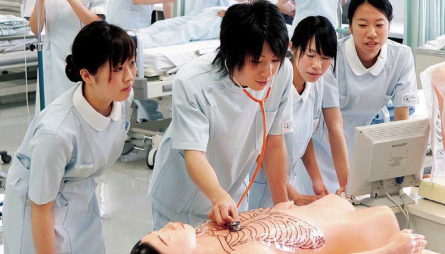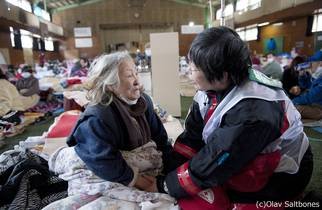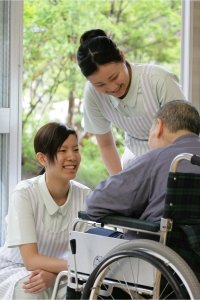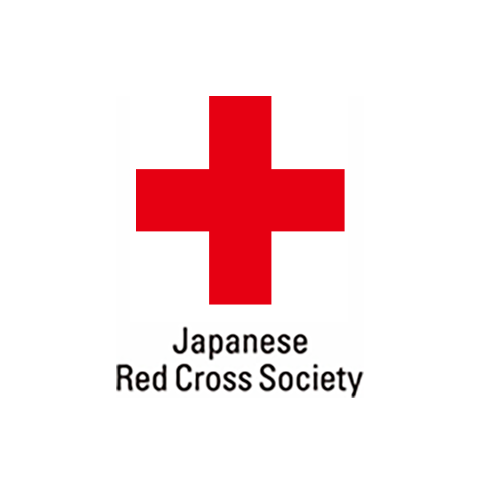Nursing Education
Securing distinguished aid workers and improving the quality of care that nurses and other medical personnel provide is an important task for the Japanese Red Cross Society. This allows the JRCS to carry out its obligations in terms of medical assistance and is thus one of the organization's primary missions.
In recent years, the nursing staff's duties have increased due to advances in medical technology, changing disease structures, and an aging society with a continuously decreasing birthrate. Along with this, medical treatment is becoming more sophisticated and diversified. This means that nurses must keep up with these advances in order to provide the appropriate care.
Major Features

The JRCS has medical facilities and educational facilities throughout the nation where the Red Cross Society's strengths and resources are fully utilized to help people build the skills they need in their field.
The Japanese Red Cross Society started training nurses specifically for disaster relief in 1890. Currently, approximately 1,300 registered nurses graduate annually from its 6 nursing colleges (graduate courses included), 14 nursing schools and 1 midwife school.

JRCS nurse training facilities aim to train medical personnel with well-rounded characters and wide-ranging competencies related to nursing. With such training these people are capable of contributing to society by engaging in a variety of activities such as health care service, disaster relief and international medical activities. Part of their training involves learning about the Red Cross principles in the hope that they may become strong advocates of the Red Cross ideals. In addition to the required subjects set forth by the national government, the JRCS curriculum for nursing schools incorporates subjects such as "Human Rights and the Red Cross," "Disaster Nursing Theory" - related to medical care during disasters - practical training on emergency relief work, and foreign languages.
In addition to working at medical and training facilities, JRCS nursing school graduates are involved in domestic disaster relief work, and are also active in international aid work in emergency situations overseas. For this reason, they are highly esteemed globally. Among the approximate 37,600 registered nurses working at Red Cross hospitals around the country, around 40% of them are graduates of JRCS nursing programs.
The JRCS nurse training facilities emphasize disaster nursing education. In recognition of this, "Disaster Nursing" was made a required subject in the Japanese nursing curriculum in 2009, and related problems are now included in the Japanese National Nursing Exam. The JRCS contributes to disaster nursing training overseas as well. Following the Sumatra earthquake and tsunami in 2005, the JRCS introduced disaster nursing courses at 4 nursing schools in Sumatra as a part of the reconstruction assistance program.

The JRCS also introduced the "Red Cross Facility Career Development Ladder" program for nursing personnel working at Red Cross hospitals and training facilities across the nation. This is a self-improvement program, which sets career development goals, in phases, for nursing staff. There are four different levels that can be attained: "nurse practitioner," "nursing supervisor," "teacher of nursing" and "international relief and development cooperative personnel." Through the program, participants set their own goals and undertake the training and education necessary to attain them. It is used as a tool to help nursing staff improve their professional skills in a step-by-step process, while receiving support from the workplace. Furthermore, by taking advantage of the system, staff members can gain greater job satisfaction; as an extension of human resource development, it promotes the exchange of personnel and is projected to result in improvements in the overall quality of the Japanese Red Cross Society.
For nurses and other staff who are expected to be active as administrators in the future, the JRCS established the "Japanese Red Cross Society Executive Nurse Training Centre" to provide a high level of education in preparation for these positions. It aims to develop skills that improve relief work, nursing services, and nursing administration of the Japanese Red Cross Society. The goal here is to train nurses that play active roles as organizational promoters and reformers, who approach their work with an unprecedented originality and creativity based on the humanitarian principles of the Red Cross. In addition to training nurses, the JRCS nursing colleges offer advanced courses to train specialized, certified nurses who can support the development of high-level professionals capable of handling advanced medical care.
The Florence Nightingale Medal is the world's highest honor that can be bestowed upon nurses and nursing aides. It was first awarded in 1920 to commemorate the 100th anniversary of Nightingale's birth, and has since been awarded every two years to nurses from around the world who demonstrated outstanding achievements that year. 110 Japanese nurses received the award by 2019. This is the largest number of Nightingale laureates from any one nationality in the world.
Protecting pregnant women and nurturing healthy infants is an important task that the JRCS undertakes by training competent midwives. Midwife education is conducted at 1 nursing school, 1colleges, and 4 college graduate schools, from which 88 midwives graduate every year. This is equivalent to roughly 3.1% of Japan's midwife training.




